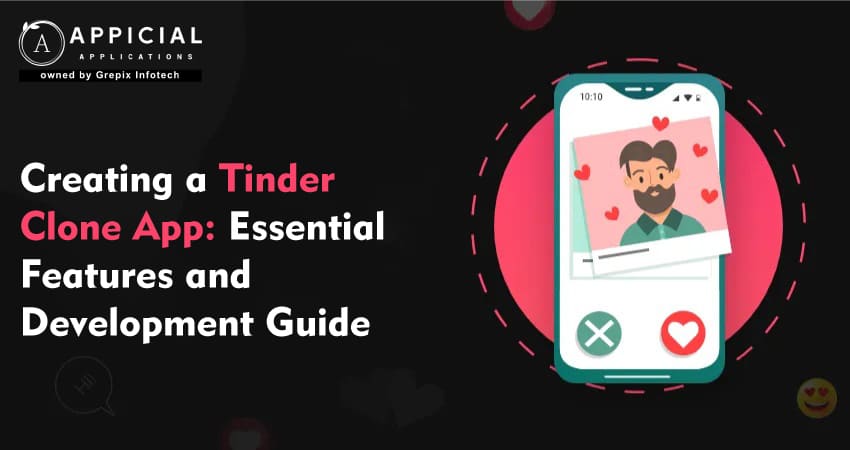
Creating a Tinder Clone App: Essential Features and Development Guide
Let’s rewind the clock to the early 2010s.
Back then, the idea of finding love online still carried a bit of a stigma. Dating apps existed, sure but they were clunky, awkward, and often resembled online classifieds more than places of meaningful connection. Then came Tinder, and with a single swipe, the dating world changed forever.
Tinder didn’t just introduce a better UI; it revolutionized how people meet. Casual, gamified, and instantly gratifying, it put power in the palm of your hand. One swipe could mean a date, a new friend, or even a lifelong partner. That core mechanic, swiping left or right, is now embedded in modern dating culture.
Fast forward to today, and Tinder’s influence is everywhere. But here’s the best part: despite the competition, there’s still room for innovation.
Whether you’re a solo developer with an idea, a startup founder eyeing the dating market, or a tech enthusiast looking for your next big project, creating a Tinder Clone App could be your ticket into a billion-dollar industry. But remember: this isn’t just about copying features. It’s about understanding what makes Tinder tick and improving upon it.
In this comprehensive guide, we’ll break down everything you need to know, from must-have features to tech stacks and marketing strategies, to build a dating app that stands out in the crowded digital arena.
Creating a Tinder Clone App involves replicating Tinder's core features like user authentication, geolocation, swipe functionality, and matching algorithms while adding unique elements to stand out in the competitive market. Essential features include profile setup, instant messaging, media sharing, push notifications, and robust security measures. The development process involves market research, defining requirements, selecting the right technology stack, designing an intuitive user interface, developing an MVP, rigorous testing, and strategic marketing. By focusing on user experience and continuous improvement, you can build a successful dating app that resonates with users and thrives in today's digital landscape.
Introduction
The success of Tinder has revolutionized the online dating industry, making it easier for people to connect and find potential partners. The concept of a Tinder Clone App involves replicating Tinder's core functionalities while incorporating unique features to stand out in the competitive market. In this guide, we will discuss the essential features that should be included in a Tinder Clone App and the step-by-step development process to bring your app idea to life.
Essential Features of a Tinder Clone App
1. User Authentication
A robust user authentication system is the foundation of any dating app. For a Tinder Clone App, consider implementing:
- Email and Password Authentication: A basic method for users to sign up and log in using their email addresses.
- Social Media Integration: Allow users to sign up and log in using their social media accounts like Facebook, Google, or Instagram. This not only simplifies the process but also helps in gathering user data for better profile suggestions.
2. User Profile
A well-designed user profile is crucial for a Tinder Clone App. Essential elements include:
- Profile Picture: Users should be able to upload multiple pictures.
- Personal Information: Basic details like name, age, gender, and bio.
- Interests and Preferences: Users can specify their interests and what they are looking for in a match.
3. Geolocation
Geolocation is a key feature of any dating app. It enables users to find potential matches within a specific radius. For a Tinder Clone App, integrating geolocation services allows users to:
- Set Location Preferences: Users can adjust their search radius.
- Discover Nearby Users: The app should show potential matches based on the user’s current location.
4. Swipe Feature
The swipe feature is the hallmark of Tinder’s user experience. It allows users to express interest in potential matches through a simple gesture:
- Swipe Right: Indicating interest.
- Swipe Left: Indicating disinterest.
5. Matching Algorithm
A sophisticated matching algorithm is essential for a Tinder Clone App. It should consider various factors like:
- User Preferences: Age, gender, location, and interests.
- Activity Levels: How active the user is on the app.
- Mutual Interests: Common interests and friends (if using social media integration).
6. Chat and Messaging
Once a match is made, users should be able to communicate through the app. Key features include:
- Instant Messaging: Allow users to send and receive messages in real-time.
- Media Sharing: Users should be able to share images, videos, and other media files.
- Read Receipts: Indicate whether a message has been read by the recipient.
7. Push Notifications
Push notifications keep users engaged and informed. For a Tinder Clone App, consider notifications for:
- New Matches: Notify users when they have a new match.
- Messages: Alert users of new messages.
- Profile Visits: Inform users when someone views their profile.
8. Privacy and Security
Ensuring user privacy and security is paramount in a dating app. Essential features include:
- Profile Verification: Verify user profiles to ensure authenticity.
- Block and Report: Allow users to block or report inappropriate behavior.
- Data Encryption: Secure user data with encryption protocols.
Development Guide
Step 1: Market Research
Before diving into the development process, conduct thorough market research to understand your target audience and competitors. Identify the unique selling points of your Tinder Clone App that will differentiate it from existing apps.
Step 2: Define Requirements
Based on your research, create a detailed list of features and functionalities for your app. Prioritize essential features and identify any additional features that can enhance the user experience.
Step 3: Choose the Technology Stack
Selecting the right technology stack is crucial for the success of your Tinder Clone App. Commonly used technologies include:
- Frontend: React Native or Flutter for cross-platform development.
- Backend: Node.js, Django, or Ruby on Rails.
- Database: MongoDB or PostgreSQL.
- Geolocation Services: Google Maps API or Mapbox.
- Push Notifications: Firebase Cloud Messaging or OneSignal.
Step 4: Design the User Interface
A user-friendly and visually appealing interface is vital for user engagement. Work with designers to create wireframes and prototypes that outline the app’s layout and user flow. Ensure that the design is intuitive and easy to navigate.
Step 5: Develop the MVP
Start by developing a Minimum Viable Product (MVP) that includes the core features of your Tinder Clone App. This allows you to test the app in the market and gather user feedback for further improvements. Key components of the MVP should include:
- User Authentication
- User Profile
- Geolocation
- Swipe Feature
- Matching Algorithm
- Chat and Messaging
Step 6: Implement Additional Features
Based on user feedback from the MVP, continue to develop and implement additional features like push notifications, profile verification, and advanced security measures. Ensure that each new feature is thoroughly tested before deployment.
Step 7: Testing
Rigorous testing is essential to ensure the app functions smoothly. Conduct various types of testing, including:
- Unit Testing: Test individual components.
- Integration Testing: Ensure different components work together seamlessly.
- User Acceptance Testing (UAT): Gather feedback from real users to identify any usability issues.
Step 8: Launch and Marketing
Once the app has been thoroughly tested and refined, prepare for the launch. Create a marketing strategy to promote your Tinder Clone App and attract users. Utilize social media, influencer partnerships, and targeted advertising to reach your audience.
Step 9: Post-Launch Support and Updates
After the launch, provide ongoing support to address any issues and release regular updates with new features and improvements. Monitor user feedback and continuously enhance the app to maintain user engagement and satisfaction.
Conclusion
Replicating Tinder’s features is easy. Building a successful dating experience is where the real challenge lies.
By focusing on intuitive design, robust functionality, privacy, and unique touches, like video, games, or AI- you can create a dating app that not only competes with Tinder but adds value to users' lives.
Remember: behind every swipe is a person hoping to connect. Build your app with empathy, creativity, and technical finesse, and your Tinder Clone App could become the next breakout hit in the world of online romance.
Creating a Tinder Clone App involves careful planning, development, and execution. By incorporating essential features like user authentication, geolocation, swipe functionality, and a sophisticated matching algorithm, you can create a compelling dating app that attracts and retains users. Following a structured development process, from market research to post-launch support, will ensure your app's success in the competitive dating app market.Building a Tinder Clone App is not just about replicating Tinder’s features but also about understanding your target audience and offering unique value propositions. With the right approach and dedication, your Tinder Clone App can carve out its niche and become a popular platform for users seeking meaningful connections.
Whether you’re a developer looking to create your first dating app or an entrepreneur aiming to enter the dating app market, this guide provides a comprehensive overview of the essential steps and features needed to develop a successful Tinder Clone App. By focusing on user experience, security, and continuous improvement, you can build a dating app that stands out and thrives in today’s digital landscape.
Launch your vision with our mobile app development company, where innovation meets excellence to create cutting-edge mobile solutions.





